Applying for an Australia Permanent Residency (PR) Visa opens the door to a secure future in one of the world’s most livable countries. Australia’s PR pathways are designed for skilled professionals, families, and entrepreneurs who wish to build a long-term life in the country.
With a transparent, points-based system, streamlined visa options, and strong government support for migration, Australia continues to attract thousands of new residents each year. The process involves meeting eligibility criteria, scoring competitively under the SkillSelect system, and submitting a complete application through the Department of Home Affairs.
An Australia Permanent Residency (PR) Visa allows individuals from around the world to live, work, and study in Australia indefinitely. It is primarily meant for skilled professionals, families of Australian citizens or PR holders, and investors or business owners who want to make Australia their long-term home.
As a permanent resident, you enjoy most of the rights and privileges of Australian citizens, including access to Medicare (public healthcare), free or subsidized education, and social security benefits once eligible. PR holders can also sponsor eligible family members and apply for Australian citizenship after meeting the required residency period.
*Want to apply for Australian PR? Sign up with Y-Axis to guide you with the process.
Applying for an Australia Permanent Residency (PR) Visa offers long-term stability, a high standard of living, and access to the same opportunities enjoyed by Australian citizens. As one of the world’s most welcoming and prosperous nations, Australia provides PR holders with numerous benefits that make it an ideal destination for skilled migrants and families.
Live, Work, and Study Anywhere in Australia
PR holders can freely live and work in any state or territory without employer or regional restrictions.
Access to Medicare (Public Healthcare)
Enjoy Australia’s world-class Medicare system, which provides free or subsidized medical care and hospital services.
Quality Education for Children
Children of PR holders can attend public schools at no cost, and tertiary education is offered at domestic student rates.
Strong Job Market and Career Growth
Australia has a robust economy with ongoing demand for skilled workers across sectors such as healthcare, IT, engineering, and education.
Pathway to Citizenship
After fulfilling the residency requirement (typically four years of lawful stay, including one year as a permanent resident), PR holders can apply for Australian citizenship.
Social Security and Family Benefits
After a qualifying period, permanent residents become eligible for certain social security and family support benefits under Services Australia.
Australia offers several visa pathways to obtain Permanent Residency (PR), each tailored to different applicant profiles such as skilled professionals, employers, investors, entrepreneurs, and family members of citizens or permanent residents. Below are the main PR visa streams under the Australian Government’s Migration Program.
The Skilled Migration Stream is the most popular pathway to permanent residency. It operates through a points-based system under SkillSelect, assessing applicants on age, education, work experience, English proficiency, and other factors.
Key visa options include:
Applicants must score at least 65 points to be eligible for an invitation. Invitation rounds are conducted periodically by the Department of Home Affairs based on Australia’s labour market demand.
The Employer Nomination Scheme (Subclass 186) and Regional Sponsored Migration Scheme (Subclass 187) allow skilled workers to obtain PR through employer nomination.
Key features:
For investors and entrepreneurs, the Business Innovation and Investment Program (BIIP) offers a pathway to PR through innovation and capital contribution.
Key visa types:
Applicants must demonstrate a successful business history, meet minimum investment or turnover thresholds, and be nominated by a state or territory government.
This stream allows Australian citizens and PR holders to sponsor close family members to live in Australia permanently.
Main visa options include:
These visas aim to reunite families and provide them with the right to live, study, and work in Australia indefinitely.
Australia also grants permanent residency through its Humanitarian Program to people fleeing persecution or conflict.
Key visa options:
Holders of these visas receive permanent residence, access to healthcare and education, and protection under Australian law.
To qualify for an Australia Permanent Residency (PR) Visa, applicants must meet the following requirements set by the Department of Home Affairs. These apply mainly to skilled migration pathways (Subclass 189, 190, and 491) but are also relevant for other PR streams.
| Eligibility Factor | Requirement (as per Department of Home Affairs) |
| Age Limit | Must be under 45 years at the time of invitation for skilled PR visas. Applicants aged 25–32 years receive maximum age points under the points test. |
| Education & Skills Assessment | Must hold a recognized qualification relevant to the nominated occupation. A positive Skills Assessment from an authorized body (e.g., ACS, Engineers Australia, VETASSESS) is mandatory. The occupation must be listed on the Skilled Occupation List (SOL) or Regional Occupation List (ROL). |
| Work Experience | Minimum 1 year of full-time skilled work experience in the last 10 years. Extra points are awarded for 3, 5, or 8 years of experience. Australian work experience in a related occupation earns additional points. |
| English Language Proficiency | Must demonstrate English ability through approved tests (IELTS, PTE Academic, TOEFL iBT, OET, or Cambridge C1 Advanced). Minimum level: Competent English (IELTS 6.0 or PTE 50 in each band). Higher scores (Proficient/Superior) earn bonus points. |
| Proof of Funds | Must show sufficient financial capacity to support yourself and dependents after arrival. Required funds vary depending on visa subclass and number of dependents. |
| Health & Character | Must complete a medical examination by an approved panel physician and obtain Police Clearance Certificates from all countries lived in for 12+ months in the past 10 years. Must meet health and character standards to be granted PR. |
.webp)
The Australia PR Points System determines eligibility for skilled migration visas such as Subclass 189, 190, and 491. Managed under the SkillSelect system, applicants must score at least 65 points to qualify for an invitation to apply for permanent residency.
Points are awarded based on factors that assess your ability to contribute to Australia’s economy and society.
| Category | Maximum Points | Criteria |
| Age | Up to 30 points | Highest points for ages 25–32; zero after age 45. |
| English Language Proficiency | Up to 20 points | Competent English (IELTS 6.0 each band) = 0 points, Proficient (IELTS 7.0) = 10 points, Superior (IELTS 8.0) = 20 points. |
| Skilled Work Experience (Outside Australia) | Up to 15 points | 3–4 years = 5 points, 5–7 years = 10 points, 8+ years = 15 points. |
| Skilled Work Experience (In Australia) | Up to 20 points | 1–2 years = 5 points, 3–4 years = 10 points, 5–7 years = 15 points, 8+ years = 20 points. |
| Educational Qualifications | Up to 20 points | Doctorate = 20, Bachelor/Master’s = 15, Diploma/Trade = 10. |
| Australian Study Requirement | 5 points | For completing at least 2 academic years of study in Australia. |
| Specialist Education Qualification | 10 points | For postgraduate studies in STEM (Science, Technology, Engineering, Maths) fields. |
| Partner Skills | Up to 10 points | For partners under 45 with competent English and a positive skills assessment. |
| State or Territory Nomination (Subclass 190) | 5 points | For being nominated by an Australian state or territory. |
| Regional Nomination (Subclass 491) | 15 points | For being sponsored by a regional employer or family member. |
| Other Factors | 5–10 points | For completing a Professional Year in Australia, community language credentials (NAATI), or having a relative in a regional area. |
Minimum Requirement: A total of 65 points is required to lodge an Expression of Interest (EOI). However, higher scores (typically 85+) increase the chances of receiving an invitation during selection rounds.
*Check your eligibility to become a Permanent Resident of Australia with the FREE Y-Axis Australia immigration Points Calculator and get an instant score!
Here are effective ways to boost your overall points score under the Australian PR system:
Follow these key steps to apply for an Australia PR Visa through the official Department of Home Affairs process.
Step 1 – Choose the Right Australia PR Visa Subclass
Select the visa that matches your profile — Subclass 189 (Independent), Subclass 190 (State Nominated), or Subclass 491 (Regional). Each has unique eligibility criteria and nomination rules.
Step 2 – Get Skills Assessment and English Test
Obtain a positive Skills Assessment from an authorized assessing body and complete an approved English test (IELTS, PTE, TOEFL, OET, or Cambridge).
Step 3 – Submit Expression of Interest (EOI)
Create and submit your EOI through SkillSelect, including your age, qualifications, work experience, and English scores. You’ll receive a points score that determines your eligibility for invitation.
Step 4 – Receive Invitation and Apply for PR
If selected, you’ll receive an Invitation to Apply (ITA). Submit your visa application online via ImmiAccount within 60 days, along with required documents and fees.
Step 5 – Wait for Decision and Get PR Grant
IRCC reviews your application and may request biometrics or medicals. Once approved, you’ll receive your Visa Grant Notice, confirming your permanent resident status in Australia.
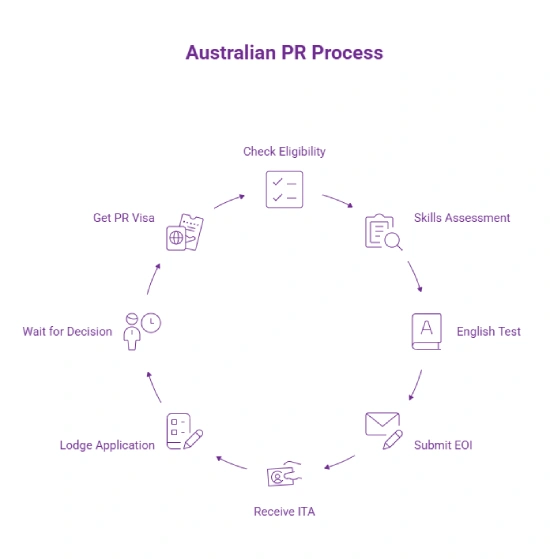
The cost and processing time for an Australia Permanent Residency (PR) Visa depend on the visa subclass, number of dependents, and individual circumstances. All fees are set and reviewed by the Department of Home Affairs and must be paid in Australian dollars (AUD).
| Category | Maximum Points | Criteria |
| Age | Up to 30 points | Highest points for ages 25–32; zero after age 45. |
| English Language Proficiency | Up to 20 points | Competent English (IELTS 6.0 each band) = 0 points, Proficient (IELTS 7.0) = 10 points, Superior (IELTS 8.0) = 20 points. |
| Skilled Work Experience (Outside Australia) | Up to 15 points | 3–4 years = 5 points, 5–7 years = 10 points, 8+ years = 15 points. |
| Skilled Work Experience (In Australia) | Up to 20 points | 1–2 years = 5 points, 3–4 years = 10 points, 5–7 years = 15 points, 8+ years = 20 points. |
| Educational Qualifications | Up to 20 points | Doctorate = 20, Bachelor/Master’s = 15, Diploma/Trade = 10. |
| Australian Study Requirement | 5 points | For completing at least 2 academic years of study in Australia. |
| Specialist Education Qualification | 10 points | For postgraduate studies in STEM (Science, Technology, Engineering, Maths) fields. |
| Partner Skills | Up to 10 points | For partners under 45 with competent English and a positive skills assessment. |
| State or Territory Nomination (Subclass 190) | 5 points | For being nominated by an Australian state or territory. |
| Regional Nomination (Subclass 491) | 15 points | For being sponsored by a regional employer or family member. |
| Other Factors | 5–10 points | For completing a Professional Year in Australia, community language credentials (NAATI), or having a relative in a regional area. |
Note: Visa application charges are reviewed periodically by the Department of Home Affairs. Additional surcharges apply for card payments.
| Visa Subclass | Average Processing Time |
| Subclass 189 – Skilled Independent | 7 to 10 months |
| Subclass 190 – Skilled Nominated | 8 to 12 months |
| Subclass 491 – Skilled Work Regional (Provisional) | 9 to 14 months |
| Subclass 186 – Employer Nomination Scheme | 5 to 11 months |
Note: Processing times vary depending on the completeness of your application, nomination availability, occupation demand, and health/security clearances.
Additional Costs
Apart from the visa application charge, applicants should also budget for:
Live, Work, and Study Anywhere in Australia
PR holders can freely reside and work in any Australian state or territory without employer or location restrictions.
Access to Medicare and Social Security
Eligible PR holders can access Medicare, Australia’s public healthcare system, which provides free or subsidized medical services. After a qualifying period, they may also be eligible for social security and family assistance through Services Australia.
Pathway to Australian Citizenship
After four years of lawful stay, including one year as a permanent resident, you can apply for Australian citizenship through the Department of Home Affairs.
Sponsor Eligible Family Members
Permanent residents can sponsor spouses, children, parents, or dependent relatives for PR or temporary visas, helping families reunite in Australia.
Free or Subsidized Education for Children
Children of PR holders can attend public schools at no cost, and tertiary education is offered at domestic tuition rates, significantly lower than international student fees.
Social and Economic Stability
PR holders enjoy job security, access to fair employment laws, and protection under the Australian legal system and Fair Work Act.
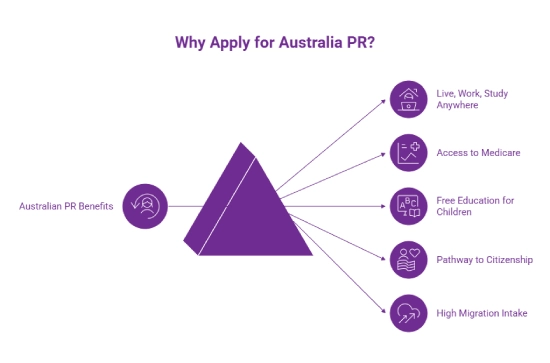
To keep your Australia Permanent Residency (PR) status valid, you must meet specific residency and travel obligations set by the Department of Home Affairs. While permanent residency gives you the right to live in Australia indefinitely, your travel facility (the right to re-enter Australia) is time-limited and must be renewed when necessary.
Becoming an Australian citizen is the final step after obtaining permanent residency, offering lifelong security, full civic rights, and access to Australia’s passport. The Department of Home Affairs manages the citizenship process, which includes meeting residency, good character, and knowledge requirements.
To apply for citizenship by conferral, you must:
Applying for an Australia Permanent Residency (PR) Visa is a detailed process, and even small errors can delay or result in refusal of your application. The Department of Home Affairs emphasizes accuracy, complete documentation, and meeting eligibility criteria at every stage.
Here are the most common mistakes applicants should avoid:
Many applicants select the incorrect visa type (e.g., applying for Subclass 189 instead of 190). Each subclass has specific eligibility and nomination requirements — choosing the right one is crucial.
Missing documents like employment references, skills assessments, or proof of funds can lead to delays or refusal. Ensure all documents meet Home Affairs’ format and certification rules before uploading to ImmiAccount.
IELTS/PTE results are valid for three years, while most Skills Assessments remain valid for three years from the issue date. Submitting expired documents can invalidate your application.
Misstating work experience, education level, or English proficiency in your Expression of Interest (EOI) can result in rejection if evidence doesn’t match. The Department cross-checks all claims with documentation.
Not updating your SkillSelect profile when gaining new qualifications, test results, or experience can lower your chances of receiving an invitation. Always keep your EOI accurate and current.
Omitting medical examinations or police certificates from all relevant countries can delay processing or lead to refusal. These are mandatory for every PR applicant and dependent.
For Subclass 190 or 491, applicants often overlook updated State Migration Lists or occupation quotas, leading to ineligible applications. Always verify your occupation before applying.
Y-Axis, the leading overseas immigration consultancy in the UK, provides unbiased immigration services for every client based on their interests and requirements. The impeccable services of Y-Axis include:
Our Accreditations | |||
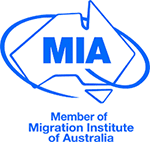 |  | 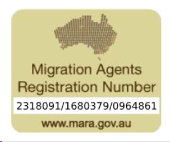 | 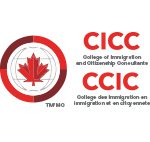 |
Explore what Global Citizens have to say about Y-Axis in shaping their future
Australia PR Visa
One of our client Varun Mathur has opted
Read More...
Australia PR Visa
Uday Seshadri giving feedback after rece
Read More...
Australia PR Visa
Y-Axis received a great feedback from Su
Read More...
The cost of applying for Australian Permanent Residency varies depending on the visa subclass and the number of applicants. For a primary applicant under the General Skilled Migration (GSM) program, the visa fee is approximately AUD 4,640. For a spouse or partner, it is around AUD 2,320, and for each dependent child, it’s AUD 1,160. Additional expenses may include health checks, police certificates, English language tests, and skill assessments.
Yes, 75 points is a competitive score for Australia’s Skilled Migration program. It increases your chances of receiving an invitation to apply for visas like Subclass 189 (Skilled Independent) or Subclass 190 (State Nominated), especially for occupations in high demand.
Yes, UK residents can apply for Australian PR if they meet the eligibility criteria under programs like Skilled Independent (Subclass 189), State Nominated (Subclass 190), or the Global Talent visa. Having relevant work experience and qualifications aligned with Australia's skill needs is key.
To get a PR visa, follow these steps:
Step 1: Check your occupation on the Skilled Occupation List.
Step 2: Get your skills assessed by an approved body.
Step 3: Take an English proficiency test (e.g., IELTS).
Step 4: Submit an Expression of Interest (EOI) via SkillSelect.
Step 5: Receive an invitation and apply for the visa.
The overall cost can range from AUD 7,000 to AUD 11,000, depending on family members, visa subclass, and other factors such as skill assessment, English tests, medical exams, and documentation.
Basic PR visa requirements are 65 points in the Points grid and have proof of having sufficient settlement funds for you and your family to sustain in Australia.
Other requirements are:
For skilled workers, the easiest route is often the General Skilled Migration pathway via Subclass 189 or Subclass 190, especially if you have a high score, in-demand occupation, and good English proficiency.
English language proficiency is required. Commonly accepted exams include IELTS (International English Language Testing System), PTE Academic, TOEFL iBT, and Cambridge English (CAE). IELTS is the most widely accepted.
Costs may include:
What are the age limits for applying for Australian PR?
Courses that align with the Skilled Occupation List improve your chances. These include IT, engineering, nursing, social work, accounting, and trade qualifications. Studying in Australia in these fields can also lead to graduate visas.
IELTS, or the International English Language Testing System, is a test that many people take when they want to move to Australia permanently. The Australian government uses IELTS score to measure someone’s ability to speak and understand English. IELTS is accepted by most universities in Australia as well. If you want to get a high score on the IELTS test, there are some things you can do to prepare yourself and make sure you understand the material.
IELTS is an academic and general training test has all four skills: listening, reading, writing and speaking. Academic IELTS is for those who want to study at university or join a professional organization in an English-speaking country.
Most universities in Australia accept IELTS as a method of testing someone’s English language capabilities. If an applicant has completed their secondary schooling or tertiary education in an English-speaking country, they may not need to provide an IELTS score. Work experience can also be used as evidence of English proficiency.
IELTS has few critical components in the system. The minimum score of 6 in each area (Speaking, Listening, Reading, and Writing) is required. If you get higher score will gain you more points!
Points Table for IELTS Score
| IELTS Score | Points |
| Score 6.0 or more | 0 |
| Score 7.0 or more | 10 |
| Score 8.0 or more | 20 |
The minimum required points are 65, but higher scores significantly improve your chances. Invitations are generally extended to those with 75 or more points depending on occupation and competition.
A permanent resident can stay outside Australia for up to 5 years without losing their PR status. After this period, you will need a Resident Return Visa (RRV) to re-enter the country as a PR.
Step 1: Choose the right PR visa stream (e.g., Subclass 189, 190, 491, 186, or 187).
Step 2: Check if your occupation is listed on the relevant Skilled Occupation List.
Step 3: Complete a skills assessment through the designated assessing authority for your occupation.
Step 4: Take an approved English language test (e.g., IELTS, PTE) and meet the required score.
Step 5: Calculate your points and ensure you meet the minimum 65-point threshold.
Step 6: Submit an Expression of Interest (EOI) via SkillSelect.
Step 7: Wait to receive an invitation to apply (ITA) from the Department of Home Affairs.
Step 8: Lodge your PR application online with all required documents and pay the visa fee.
Step 9: Complete biometrics, health checks, and police clearances.
Step 10: Await a decision from the Department of Home Affairs and receive your PR grant if approved.
Yes. You must demonstrate English proficiency via tests like IELTS General Training, PTE Academic, TOEFL iBT, or others specified by the Department of Home Affairs. Achieving Competent English (e.g., IELTS 6.0 in each band, PTE 50) earns baseline points; Proficient or Superior English (e.g., IELTS 7.0 or 8.0) can significantly boost your PR application score.
Yes, Australia’s Department of Home Affairs (DHA) website features a comprehensive Visa Finder tool to compare eligibility, costs, and timelines. Independent comparison charts are available showing major differences between Subclasses 189, 190, 491 and employer-sponsored 186/187, including nomination requirements, work and living conditions, and points thresholds.
Firstly, check if your occupation appears on the Skilled Occupation List (SOL) and complete your skills assessment. Then estimate your points based on age, English proficiency, qualifications, and experience. Use the SkillSelect point calculator to determine eligibility for 189, 190, or 491, and research state-nominated pathways aligned with your occupation and location preferences.
Visa application fees vary:
Look for a registered Migration Agent listed on the Office of the Migration Agents Registration Authority (OMARA) website. Ensure the agent has a valid registration number and check reviews or testimonials. You may also work with licensed immigration firms or consultants accredited under Australian law. Online directories and government-authored lists help you find qualified and trustworthy assistance.
For comprehensive and reliable support with your Australian PR application, Y-Axis is a trusted and globally recognized immigration consultancy. Y-Axis offers end-to-end assistance including eligibility assessment, document preparation, Expression of Interest (EOI) filing, and application submission. With experienced case managers, personalized guidance, and dedicated support for skilled, family, and business visa streams, Y-Axis helps you navigate Australia’s complex immigration system with confidence and clarity.
To apply for Australian PR, you generally need:
If you are an Australian permanent resident living in the UK, you must apply for a Resident Return Visa (RRV) to maintain your status. To renew, you typically need to show:
To qualify for an Australia PR Visa, you must score a minimum of 65 points on the immigration points test. Points are awarded based on key factors such as age, education, English language proficiency, work experience, and skilled occupation. Higher scores increase your chances of receiving an Invitation to Apply (ITA) through the SkillSelect system. Applicants scoring 80 points or above generally receive invitations faster under competitive streams like the Skilled Independent Visa (subclass 189) or Skilled Nominated Visa (subclass 190). A professional skills assessment and English test results (IELTS, PTE, or TOEFL) are mandatory to calculate your final score.
Yes, you can apply for Australia PR without a job offer through points-based skilled migration programs such as the Skilled Independent Visa (subclass 189) or the Skilled Nominated Visa (subclass 190). These visas assess applicants based on qualifications, experience, and skills rather than employer sponsorship. You must have your occupation listed on Australia’s Skilled Occupation List (SOL) and obtain a positive skills assessment from an approved authority. While a job offer is not required, having one may strengthen your overall profile, especially for state nominations or regional visas (subclass 491), where specific skills are in demand.
The processing time for an Australia PR Visa typically ranges between 6 to 12 months, depending on the visa subclass, the completeness of your application, and the accuracy of your documents. The Department of Home Affairs prioritizes certain occupations and regional applications, which can lead to faster decisions. Applicants with higher points, in-demand skills, and prompt responses to document requests are often processed quicker. However, incomplete details, additional verifications, or medical and police clearances may cause delays. Planning ahead and submitting a well-prepared application helps ensure timely approval of your PR visa.
The cost of applying for an Australia PR Visa varies based on the visa type and the number of applicants included. As of 2025, the base application fee for the primary applicant ranges between AUD 4,240 to AUD 4,640. For a spouse or partner, the fee is around AUD 2,320, and for each dependent child, it’s approximately AUD 1,160. Additional expenses include skills assessment fees (AUD 300–1,000), English language test (AUD 300–400), medical exams, and police clearance certificates. The total cost can vary depending on family size and specific visa subclass.
Australia offers several vibrant cities known for their quality of life, career opportunities, and multicultural environment. The top cities to live in after obtaining PR include:
Note: Each city offers strong infrastructure, public healthcare, and a high standard of living for PR holders.